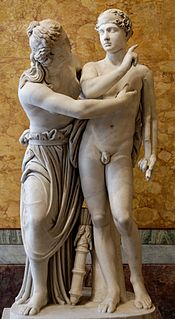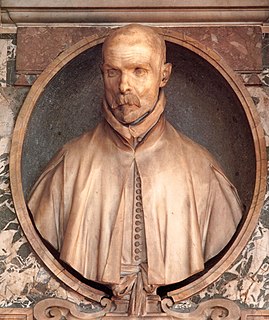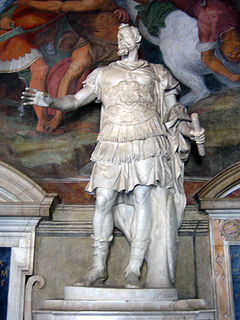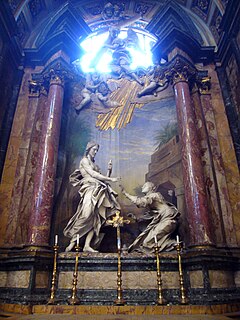Related Research Articles

Gian LorenzoBernini was an Italian sculptor and architect. While a major figure in the world of architecture, he was more prominently the leading sculptor of his age, credited with creating the Baroque style of sculpture. As one scholar has commented, "What Shakespeare is to drama, Bernini may be to sculpture: the first pan-European sculptor whose name is instantaneously identifiable with a particular manner and vision, and whose influence was inordinately powerful ..." In addition, he was a painter and a man of the theater: he wrote, directed and acted in plays, for which he designed stage sets and theatrical machinery. He produced designs as well for a wide variety of decorative art objects including lamps, tables, mirrors, and even coaches.

Blessed Ludovica Albertoni is a funerary monument by the Italian Baroque artist Gian Lorenzo Bernini. The Trastevere sculpture is located in the specially designed Altieri Chapel in the Church of San Francesco a Ripa in Rome, Italy. Bernini started the project in 1671, but his work on two other major works—The Tomb of Pope Alexander VII and the Altar of the Blessed Sacrament in St. Peter's Basilica—delayed his work on the funerary monument. Bernini completed the sculpture in 1674; it was installed by 31 August 1674.

Ippolito Buzzi (1562–1634) was an Italian sculptor from Viggiù, near Varese, in northernmost Lombardy, a member of a long-established dynasty of painters, sculptors and architects from the town, who passed his mature career in Rome. His personality as a sculptor is somewhat overshadowed by the two kinds of work he is known for: restorations to ancient Roman sculptures, some of them highly improvisatory by modern standards, and sculpture contributed to architectural projects and funeral monuments, where he was one among a team of craftsmen working under the general direction of an architect, like Giacomo della Porta - in projects for Pope Clement VIII, or Flaminio Ponzio - in projects for Pope Paul V - who would provide the designs from which the work was executed, always in consultation with the patron.

Bust of Monsignor Pedro de Foix Montoya is a sculpted portrait by the Italian artist Gianlorenzo Bernini. Executed in 1621 and 1622, it sits within a larger tomb created for Montoya, a Spanish lawyer working in Rome. The tomb was originally in the Spanish national church in Rome, San Giacomo degli Spagnuoli, but was moved in the nineteenth century when the church fell out of Spanish possession. The monument now sits in the refectory attached to the Roman church of Santa Maria di Monserrato. The architecture for the tomb was undertaken by Orazio Turriani.

Memorial to Maria Raggi is a sculptural monument designed and executed by the Italian artist Gian Lorenzo Bernini, started in 1647 and finished in 1653. The monument is attached to a pillar in a nave of the church of Santa Maria sopra Minerva in Rome.

The Bust of Giovanni Battisti Santoni is a sculptural portrait by the Italian artist Gian Lorenzo Bernini. Believed to be one of the artist's earliest works, the bust forms part of a tomb for Santoni, who was majordomo to Pope Sixtus V from 1590 to 1592. The work was executed sometime between 1613 and 1616, although some have dated the work as early as 1609, including Filippo Baldinucci. The work remains in its original setting in the church of Santa Prassede in Rome.

The Bust of Francesco Barberini is a marble sculpture by the Italian artist Gian Lorenzo Bernini, now in the National Gallery of Art in Washington, D.C. It was executed in 1623. It was commissioned by Pope Urban VIII, who was nephew of Francesco Barberini, an apostolic protonotary. Francesco had actually died in 1600 so Bernini created the bust from an existing painted portrait. The painted portrait is in Corsini Collection in Florence; Bernini made close use of the design, although the painting was a three quarter portrait as opposed to a bust of head, shoulders and upper body.

The Bust of Costanza Bonarelli is a marble portrait sculpture by the Italian artist Gian Lorenzo Bernini, created in the 1630s. It is now in the Museo Nazionale del Bargello in Florence, Italy. Considered among the most personal of Bernini's work, the bust depicts Costanza Piccolomini Bonarelli, the wife of Matteo Bonarelli, one of Bernini's pupils and coworkers. Bernini fell passionately in love with her. It is an exceptional sculpture in that it breaks with the tradition of seventeenth century portrait sculpturing and previews the style of the next century.

The Bust of Alessandro Peretti di Montalto is a portrait sculpture by the Italian artist Gian Lorenzo Bernini. Executed in 1622 and 1623, the sculpture is now in the Kunsthalle Hamburg, in Germany. Although possibly mentioned by one of Bernini's early biographers, the bust had been considered lost and therefore makes no appearance in Rudolf Wittkower's catalogue of Bernini’s sculptures of 1955. However, the bust was identified in the 1980s and is now considered an authentic work by Bernini.
The Bust of Cardinal Giovanni Dolfin or Delfin is a sculptural portrait by the Italian artist Gian Lorenzo Bernini, which is part of a mausoleum for the Venetian Cardinal Giovanni Delfin, member of one of Venice's most ancient noble families. The tomb as a whole was a joint work commissioned of Bernini and his father Pietro. While Gianlorenzo executed the portrait bust, Pietro carried out the surrounding figures, including two allegorical figures of Faith and Hope as well as the Delfin family coat of arms. The work was completed in late 1621, and sits in the church of San Michele in Isola.

The Blessed Soul is a bust by the Italian artist Gian Lorenzo Bernini. Executed around 1619, it is a pendant piece to the Damned Soul. Their original location was sacristy of the church of San Giacomo degli Spagnuoli, but they were then moved in the late 19th century, and then to the Spanish Embassy to the Holy See in Piazza di Spagna The set may have been inspired by prints by Karel van Mallery, although they were initially categorized as nymph and satyr.

Two Angels in Sant'Agostino are two marble sculptures above the high altar of the Basilica of Sant'Agostino in Rome. They are listed as being by the Italian artist Gian Lorenzo Bernini in the biography of Baldinucci, and there is also recorded evidence of Bernini having been paid for them. However, it seems likely that Bernini passed the work over to one of his assistants, Giuliano Finelli.

The Memorial to Alessandro Valtrini is a funerary monument designed by the Italian artist Gian Lorenzo Bernini in 1639, and executed by his workshop in the same year. It is situated in the church of the San Lorenzo in Damaso in Rome. It has strong affinities with the Memorial to Ippolito Merenda; both were undertaken by Bernini's workshop and commissioned by Cardinal Francesco Barberini to commend the ecclesiastical work done by Valtrini and Merenda respectively. In aesthetic terms, both broke new ground in figuring Death as a moving skeleton carrying a flowing inscriptions and, in the case of Alessandro Valrtrini monument, a medallion-shaped portrait of Valtrini himself.

San Giacomo alla Lungara is a church in Rome (Italy), in the Rione Trastevere, facing on Via della Lungara. It is also called San Giacomo in Settimiano or in Settignano, due to its vicinity to Porta Settimiana, built by Septimius Severus and included by Aurelianus within the city walls.

The Busts of Pope Innocent X are two portrait busts by the Italian artist Gianlorenzo Bernini of Pope Innocent X, Giovanni Battista Pamphili. Created around 1650, both sculptures are now in the Galleria Doria Pamphili in Rome. Like the two busts of Cardinal Scipione Borghese, it is believed that Bernini created a second version of the bust once a flaw was discovered in the first version. There exist several similar versions of the bust done by other artists, most notably Alessandro Algardi.
The Memorial to Carlo Barberini is a large memorial, featuring two allegorical statues and an inscription. It was designed by the Italian artist Gian Lorenzo Bernini upon the death of Carlo in 1630, and subsequently executed by Bernini and his workshop. It is in the church of Santa Maria in Aracoeli in Rome.

The Statue of Carlo Barberini was a large statue of the brother of Pope Urban VIII, Carlo Barberini, erected in the Palazzo dei Conservatori, Rome, following his death in 1630. The statue made use of an existing antique statue of Julius Caesar. The Roman authorities then commissioned the two most renowned sculptures of the day, Gianlorenzo Bernini and Alessandro Algardi, to add to the torso; Bernini worked on the head and Algardi on the limbs.

The Tomb of Countess Matilda of Tuscany is a large sculptural memorial designed by the Italian artist Gianlorenzo Bernini and executed by Bernini and various other sculptors. It was commissioned by Pope Urban VIII in 1633 and was destined for St. Peter's, Rome, where it still sits now. The final parts were completed in 1644.

Noli Me Tangere is a large sculptural arrangement that forms part of the Alaleona Chapel in the church of Santi Domenico e Sisto, in Rome.
References
- Bernstock, Judith E. (June 1981). "Bernini's Memorials to Ippolito Merenda and Alessandro Valtrini". The Art Bulletin. College Art Association. 63 (2): 210–32. doi:10.1080/00043079.1981.10787873. JSTOR 3050113.
- Wittkower, Rudolf (1997). Gian Lorenzo Bernini: The Sculptor of the Roman Baroque. London: Phaidon Press. ISBN 978-0801414305.